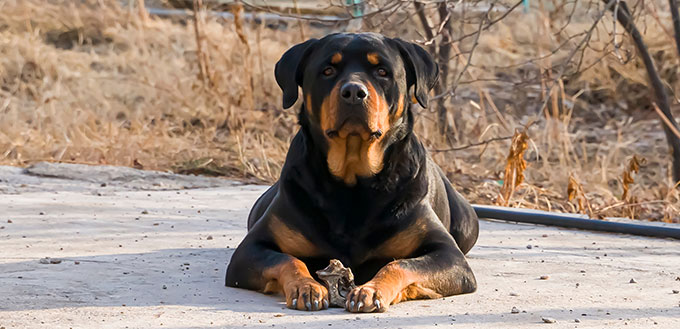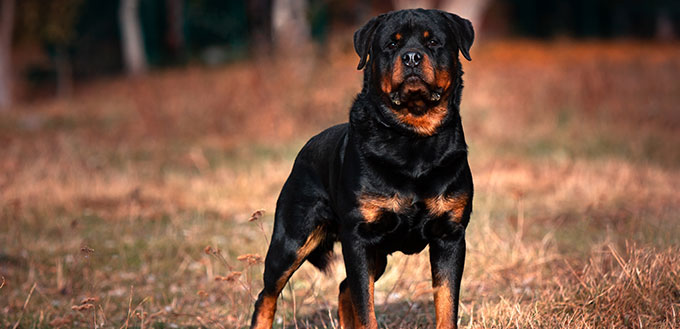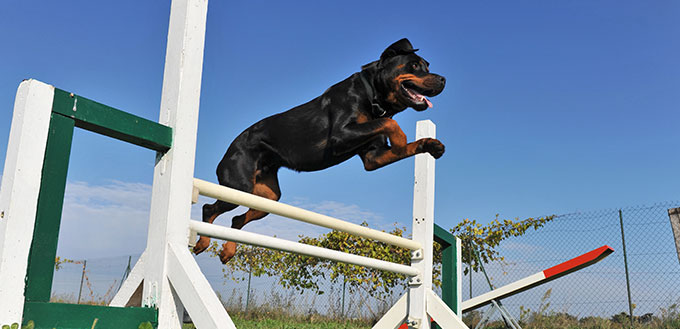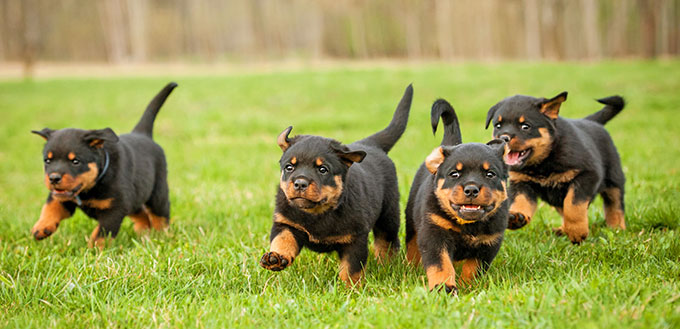Bred in Germany for jobs that required a muscular working dog, the Rottweiler is a strong, intelligent dog breed with a fearless personality. Though they originally worked alongside farmers and butchers, employed to pull carts and herd cattle, these amazing dogs can easily adapt to any family who adopts them.
The Rottweiler dog breed has been around for over one hundred years, though they were first recognized by the American Kennel Club back in 1931.
Breed Overview
- Dog Breed Group: Working dog
- Height: 24-27 inches (male), 22-25 inches (female)
- Weight: 95-135 pounds (male), 80-100 pounds (female)
- Life Expectancy: 9 to 10 years
- Color: Black and mahogany, black and rust, black and tan.
- Coat: Straight, coarse outer coat of medium length, undercoat visible on neck and upper legs
History of the Rottweiler
As we noted in the introduction, the Rottweiler was officially introduced to the world over a hundred years ago, in Germany. However, the history of the Rottweiler breed does not begin in 1901, in Germany, but instead begins back during the age of the Roman Empire.
It was the Romans that bred the ancestors of our modern day Rottweiler. Their armies needed strong dogs that could guard and had decent agility. They used Asian mastiff breeds to create their drover dogs – and these dogs eventually found work in the town of Rottweil long after the collapse of the Roman empire.
After the centuries between the Roman empire and the appearance of this descendent breed of their dogs in Rottweil, the breed had changed and become more similar to the Rottweilers that we have today; although, they still weren’t Rottweilers as we know them. After working to move herds, protecting the people, and becoming well-known and well-loved working dogs, this descendent breed became known as the Butcher’s Dog of Rottweil, or “Rottweiler Metzgerhund”.
Rottweiler Metzgerhund stopped working as a cattle dog in the 19th century when railroad cattle cars took over in their stead. They went on to become police dogs, guard dogs, and other worker-type dogs that were perfect for performing tasks that needed intelligent, strong dog breeds.
The Rottweiler was actually one of the first dog breeds to become a guide dog for individuals with sight impairments. They’ve also worked as rescue dogs!
Despite the long history of the Rottweiler breed, with all of its many jobs and changes, the temperament and overall look of the Rottweiler dog breed has barely changed at all.
A Little More About Rottweilers
The Rottweiler is a dog that needs to be socialized early on in its life. Rotties are great dog breeds that make wonderful working dogs, whether they are guide dogs, family pets, or herding cattle and sheep on a farm.
When you have Rottweiler puppies, early socialization is the key to unlocking a friendly personality within your Rottweiler dog. By training your Rotties early on in their life, you can reinforce positive behavior and help a Rottweiler dog come to grips with their natural instincts.
The Rottweiler dog, when trained and socialized correctly, can become a great friend to their human family. When Rotties are properly raised, they become calm, confident dogs. No dog is naturally aggressive; although many have this stigma because of their size and bad publicity.
In fact, your new Rottweiler friend will warm up to you in no time at all. It won’t be long until you have their full Rottweiler weight in your lap for cuddles.
In terms of personality beyond what can be achieved through socialization, Rottweilers have many good traits. They are playful, silly, and can be a bit of a couch potato. They don’t mind working but they also don’t mind lazing about, either.
When faced with a stranger, Rottweilers have a tendency to seem uninterested at best (or defensive at their worse). They won’t attack another person or animal for no reason. Rottweilers have a good head on their shoulders, and any training their owners commit to will only help with that as they become an adult dog.
The overall personality of the Rottie is one that fills their owners with confidence. Rottweiler breeders often talk about the protective and guarding nature of these dogs – no surprise there, as Rottie dogs are often employed in the police dog line of work. The Rottie is calm and courageous above all else.
Even as a Rottweiler puppy, your furry friend won’t be shy. They’ll be a curious family member, getting into everything and constantly asking for playtime. Owners of any Rottie dog will tell you how affectionate the breed is.
Puppy or adult dog, Rottweilers have high energy levels. If you want to keep your Rottweiler puppy entertained, it’s in your best interest to give your puppy a lot of playtime. That means walks, time outdoors, and maybe a small obstacle course for your puppy to run around on.
One slight difference in personality comes when you compare a female Rottweiler dog and a male Rottweiler dog. While the male Rottweiler acts the part of a guard dog – watching, waiting, being alert – the female Rottweiler is usually more affectionate. Both biological sexes of this breed of dog share many similarities, though; they’re also both very trainable dogs, though they can be stubborn.
Dog Breed Appearance
Rottweilers are considered one of the larger dog breeds, standing at between 22 and 27 inches from the floor to their shoulder. That, combined with their weight of 80 to 135 pounds, makes for a somewhat intimidating dog. However, considering their history and the various lines of work that the Rottweiler has been in over the years, it’s no surprise that this dog breed is packed with muscle.
The most common coat color for a Rottweiler is a combination of black and mahogany. According to the American Kennel Club, for a Rottweiler to qualify to be shown, they must be one of these three coat colors:
- Black and Tan
- Black and Rust
- Black and Mahogany
However, these are not the only three coat colors in existence for a Rottweiler puppy. There are also two rare coat colors that aren’t officially recognized by the American Kennel Club in the United States. These are the Red Rottweiler coat and the Blue Rottweiler coat.
Red is the rarest of the Rottweiler coats. There’s no black saddle pattern like the three coat colors recognized in the dog show scene of the United States, and the dog is often mistaken for another breed. Red coat puppies are not bred ethically, but they can sometimes appear in puppy litters unexpectedly.
As for the blue coat Rottweiler, well, it’s not so much a true blue as a gray, silver, or slate color that has blue undertones. Rottweiler puppies get this color coat when the gene that causes the black in their fur is purposefully lightened. This isn’t too hard to do with breeding, but it’s still unethical because blue coated pups are more likely to have health issues.
Interesting Facts
Fact #1
A Rottweiler raised around children may nudge or bump them. This is part of their natural herding instinct and your Rottweiler is just trying to do their job and keep your kids safe. However, when faced with younger children and toddlers, Rottweilers may accidentally bump them too hard and cause them to fall down. This is due to the size and weight difference between the Rottweiler and the child in question. They are not trying to hurt your child.
Fact #2
In some towns and cities, anyone who wants to add a Rottweiler to their family has to get extra liability insurance to be legally able to own one.
Find out more about the Best Pet Insurance Companies.
Fact #3
Rottweilers are extremely intelligent, even when the dog is still a puppy. They will test you and try to find ways around the rules and boundaries that you set out for them.
Rottweiler Temperament
No matter how much you search for a guard dog breed that’s still playful and loving, you won’t find one who characterizes those traits better than a Rottweiler. This loyal breed is known for its confidence, and its willingness to protect their family members without a second thought.
They are often seen, quite incorrectly, as aggressive dogs. The type of breed that people say shouldn’t be allowed off a leash or anywhere near children. This couldn’t be more wrong! Rottweilers have some of the best instincts of any dog breed, ensuring that you and your family stay safe from anything they see as a threat. Yes, that does mean that there will be some aggressive interactions between your Rottweiler and other dogs and humans – but only those that your Rottweiler doesn’t recognize or those that your dog believes are posing a threat to you.
Alongside their guard dog demeanor, Rottweiler dogs are also extremely affectionate. This breed will seek out pets, cuddles, and loves lying on or across laps. If you’ve ever wanted 100 pounds of dog lying on you because you’re their favorite person, now’s your chance! The Rottweiler could be the perfect dog for you.
You May Also Like 5 Things You Need To Know About a Rottweiler’s Temperament
Rottweiler Care
Rottweilers need to live with people. When you leave a dog along for long periods of time and give them no contact or anything/anyone to play with, they become bored, aggressive, and lonely. Many dogs suffer from separation anxiety, and it wouldn’t be surprising if your Rottweiler – a natural guard dog with a loyalty streak a mile long – developed this, too.
Even though they’re large dogs, Rottweilers will be as active indoors as they are outdoors. They need their own space that they can disappear to when they want to be alone or sleep, and they need toys and activities to do. Rottweilers should be walked every day, too. Overall, try to aim for around two hours of exercise per day – that’s minimum.
Don’t adopt a Rottweiler if you cannot commit to their health and needs. Rottweilers live for around nine to ten years and are active dogs in their prime. Pet parents should do as much research as possible before taking on a new dog like a Rottweiler.
Training
Training a Rottweiler may not be as difficult as it seems. They are large dogs, yes, but they’re also intelligent. Stubborn, too, so take your time when training them.
Because of their natural abilities, Rottweilers make great show dogs and can be trained for agility and obedience competitions. They can also learn to track, guard, pull carts, and some Rottweilers do end up working as police, search and rescue, support, or therapy dogs.
The Rottweiler is a breed that needs mental stimulation. These dogs are smart! They like learning and being taught new things, but they may test you from time to time; as if asking “why should I do this?”. Show them who’s in charge and remember to reward them when they do a good job.
As a puppy, toilet training and house training shouldn’t be a hardship. Rottweilers learn quicky when given a solid schedule that isn’t broken by inconsistencies.
Feeding
A high-quality dog food is needed so that your Rottweiler can grow well. Low-quality dog food is full of fillers, chemicals, and junk that isn’t at all good for your dog.
When you’re looking for a good brand of dog food, always check the ingredients for a few key things. The first ingredient should always be real meat; protein is a crucial part of a dog’s diet and mass-produced dog food typically uses the remnants of meat and animal bone that are ground up together (this is labelled as meat meal).
You should also avoid any brands that use MSG, Melamine, BHA, BHT, Ethoxyquin, Sodium Hexametaphosphate, Carrageenan, and Propylene Glycol. There’s a few others – like corn syrup and food dye – but this list is a good starting point for finding out what brands are using harmful ingredients in their dog food.
Once you’ve found a decent brand of dog food and the best food for your rottweiler, you should ensure that you read over the feeding guidelines and are not feeding your dog more than the recommended serving for their age and weight. Rottweilers have a problem with overeating, which leads to excessive weight gain and health problems for your dog. A healthy, adult male Rottweiler shouldn’t really weigh more than 135 pounds. If you’re concerned about your dog’s weight, we recommend checking in with your vet and looking into some dog breed information for your pup.
Dog treats can also be a part of a Rottweiler’s diet, but they should be utilized for training, obedience, and treats for extremely good behavior. Too many will also cause unnecessary weight gain.
Grooming
The Rottweiler has a double coat with straight hair. Their outercoat is coarse, though you may find their softer undercoat on their neck and thighs. Depending on where your Rottweiler lives, they may have more or less undercoat on show than other Rottweilers.
As the pet parent of a Rottweiler, it is your duty to brush your dog every week with a firm bristle brush. This will enable the skin oils of your Rottweiler to be distributed across their entire coat, and will also remove any dead hair. Dogs with double coats should never, ever be shaved.
Rottweilers shed twice a year, and need to be brushed more frequently during the shedding period. Bathe your dog as needed, but remember that if it’s too cold outside for you, it’s too cold outside for your dog.
Health
With any breed of dog, there’s always the potential that they may have some health issues in their life – Rottweilers are no different.
There are, however, a few health conditions that Rottweilers are prone to because of their genetics and the way they’ve been bred over time. Not all Rottweilers will suffer from these conditions, but it’s good for pet parents to know the potential health issues that could appear.
In general, Rottweilers are quite healthy. If you did or are wanting to adopt a puppy from a breeder, you should be sure to see the dog’s health clearances. These will show you that your pup doesn’t have hip dysplasia, elbow dysplasia, that their eyes are fine, that they don’t have hypothyroidism or thrombopathia, and that their overall health is okay. These clearances will come from the Orthopedic Foundation for Animals, the Canine Eye Registry Foundation, the vet the puppy is registered with, and possibly Auburn University for the thrombopathia check. You can check all of those clearances against the OFA website to confirm them, too. It sounds like a lot of work, but you’re ensuring that the puppy you want to take home doesn’t have any conditions that could end their life early or cost you thousands in vet bills and care.
Other possible health conditions in Rottweilers include heart defects like Aortic Stenosis, Osteosarcoma (bone cancer), GDV (a condition that affects some deep-chested dogs), and Panosteitis (growing pains around four months old where your puppy will limp and become lame).
They can also get allergies, which seems like such a simple and unimportant thing in the face of all of the other conditions we’ve named above… But it’s still part of a Rottweiler’s health.
As noted in the feeding section of this guide, Rottweilers are also prone to overeating and becoming overweight. This is easy enough to manage if you keep a record of feeding times during the day and ensure that none of your family members are double-feeding your pup.
Exercising
Although your Rottweiler needs a minimum of two hours of exercise a day, there’s a lot you can do with them to make that time seem like nothing! Your Rottweiler is a very active dog, they like to run, they like to play, they’re strong and they’re fast.
Taking your dog out on walks to browse the nearby scenery is a great start. Depending on your garden situation at home, you’ll want to go on a couple of walks each day so that your dog can do their business and just… Be a dog. Giving dogs time to learn their surroundings, meet other local dogs, stop and smell the flowers and roll in the grass – this is all a crucial part of their development. Set aside enough time on these walks to let your dog explore where they can (as long as it’s safe for both of you to do so).
If you do have a garden of a decent size, why not try setting up your own little (or big?) obstacle course for your Rottweiler. As we’ve mentioned, Rottweilers are smart and they take to agility training like a baby duck takes to water. You’ll soon see them running around a homemade course, and they’ll keep you on your toes asking you to play with them.
There aren’t any “requirements” for how you should exercise or train your dog, but it’s seen as the right, socially acceptable thing to do, if you have your dog learn a few basic commands and take them on walks. Commands like sit, stay, fetch, these are simple and easy to teach a smart dog like a Rottweiler.
If you are having trouble, though, there’s no harm in taking them to a local dog school. They’ll not only train your pup, but they will give you the skills that you need to train him or her, too.
Adopt Don’t Shop (Rescue Groups)
Before you buy a puppy, why not consider adopting an adult Rottweiler that needs a home? The Rottweiler Rescue Foundation in the United States of America supports a number of rescue groups across the country that assist abandoned and surrendered Rottweiler dogs.
On their website, you will quickly find a large list of rescue groups and where they are located in the country. There are approximately 17 different rescue groups being supported by the rescue foundation, from Cathy’s Rottie Rescue in the north east to Gulfstream Guardian Angels Rottweiler Rescue in southern Florida. There’s even a rescue listed for Hawaii!
When you buy from unregistered or backyard breeders, you feed into unethical breeding. The best action you can take, as someone looking to adopt a new puppy, is find reputable breeders from online research using reliable and informational websites – like the folks at the American Kennel Club and the American Rottweiler Club, who have lists of national breeders and groups that have dogs ready to be adopted.
There are plenty of puppies and adult dogs that need a home from these reputable organizations.
Reputable Breeders
The full list of reputable breeders available through the American Rottweiler Club is perhaps a bit much to include here, but to give our readers an idea of what they can expect from that list, here is some quick information:
The American Rottweiler Club Breed Referral List lists breeders by state in America, as well as their email addresses for enquiries and the type of enquiries they accept. As an example, there are eight breeders in Florida on this list, four in California, and three in Arizona.
Over the entire list, there are almost 50 breeders listed that meet the American Rottweiler Club’s standards.
Price
The average cost for a Rottweiler puppy varies from state to state. In California, they cost around $2,000, while in Pennsylvania, you can buy a Rottie for as little as $600.
Rottweilers are a more expensive breed to buy because of their strength and intelligence. They’re very sought-after dogs, but they cost a lot to keep. The estimated weekly cost for a Rottweiler is over $100, so they aren’t a dog you can take on without some kind of plan and a decent income.
However, if you were to adopt a Rottweiler from a rescue organization, you would likely only be charged an adoption fee – these are significantly less than the cost of buying a Rottweiler puppy from a breeder, and you’d be rehoming a dog that just wants a new home.
FAQs:
Q: Is a Rottweiler a good first dog?
A: We wouldn’t recommend a Rottweiler as a good dog for someone who hasn’t owned dogs before. They are large, heavy, and strong dogs, and they can be a little intimidating to new pet owners.
Rottweilers may be intelligent and loyal, but they require an owner that has the right kind of knowledge and experience with dogs that can help them raise a Rottie.
Q: Is a Rottweiler a good family dog?
A: A Rottweiler can be an amazing dog for a family to have around. They are protective, loyal, and will act as guard dogs without even really thinking about it. If you’re looking for a dog that can keep up with energetic children, there’s nothing wrong with getting a Rottie. Families with very young children might want to hold off for a few years, though, because Rottweilers try to herd children and your dog will be quite a bit bigger than your toddler.
Q: Do Rottweilers like to cuddle?
A: Rottweilers love cuddles! Despite all of the things that are said about them, this breed of dog is extremely affectionate and always happy to have cuddles with their human family. As long as you socialize your pup properly, and train them right, they’ll be as affectionate to you as any other lap dog.
Source:
- About the Rottweiler, ARC
- Rottweiler, UCDavis Vetrinary Medicine











